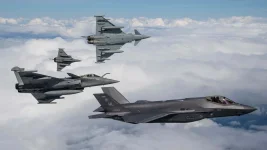An image that rapidly spread across Pakistani social media platforms, purportedly depicting a component of an Indian Air Force Rafale fighter jet allegedly shot down by Pakistan on May 7, 2025, has been conclusively identified as a fabrication. The photograph, initially presented as proof of Pakistani military success during India's 'Operation Sindoor', was thoroughly examined.
Investigations by various aviation experts, significantly supported by artificial intelligence-based image verification technologies, have determined the image to be a deliberate fake, highlighting the persistent issue of misinformation amidst the escalating tensions between India and Pakistan.
This controversy unfolded against a backdrop of Pakistani assertions that its air defence systems successfully intercepted and downed five Indian aircraft during India's 'Operation Sindoor'. The aircraft claimed by Pakistan reportedly included three advanced Rafale jets, one Su-30MKI, one MiG-29, and an Israeli-made IAI Heron surveillance drone.
India's operation, which official sources indicated involved 80 to 90 aircraft deploying BrahMos and SCALP cruise missiles, was launched as a retaliatory measure. It targeted nine alleged terrorist locations situated within Pakistan and Pakistan-administered Kashmir, following a deadly terror attack in Pahalgam on April 22, 2025, which resulted in 26 civilian fatalities.
The discredited photograph was actively disseminated by several social media accounts, including those identified as @PakistanCyberForce and @DefencePK. These posts featured a metallic structure, claimed to be the rear section of a Rafale jet, supposedly retrieved from a crash site within Pakistan.
Accompanying captions boldly asserted this as definitive evidence of a Rafale being successfully shot down by Pakistani air defence. Some social media users further alleged that the purported wreckage was discovered near Sialkot or Muzaffarabad. The image quickly gained attention online, fueling narratives of Pakistani military capability, while simultaneously prompting widespread skepticism and counter-claims from users in India.
However, scrutiny by experts soon revealed significant inconsistencies in the circulated photograph. Aviation specialists were quick to observe that the depicted aircraft component did not match the known design characteristics of a Dassault Rafale jet, which is distinguished by its delta wing configuration and two vertical stabilizers.
Furthermore, the structure shown in the image appeared incompatible with the advanced composite materials used in the construction of Rafale aircraft.
Crucially, it lacked standard identification marks, such as serial numbers or Indian Air Force (IAF) insignia, which are typically present on fragments of military aircraft wreckage.
Social media posts on platform X, including one from the account @IndianDefenceRA, suggested that the image bore a striking resemblance to older, unrelated photographs of aircraft wreckage, possibly from entirely different aircraft types or previous, unrelated incidents.
Subsequent detailed investigations, employing sophisticated AI-driven image analysis tools commonly utilized by international fact-checking organizations, definitively confirmed the photograph as a fabricated image.
These advanced digital forensic tools, engineered to detect digital manipulation or images created from scratch, identified significant anomalies. These included irregularities in pixel arrangements, inconsistent lighting that did not match natural conditions, and suspicious metadata, all suggesting that the image was either heavily edited or entirely manufactured.
These findings, specifically shadows and textures within the photograph, were inconsistent with what would be expected at an actual aircraft crash site.
This incident is reminiscent of a 2019 case where some Pakistani media outlets were found to have used a staged photograph of a downed Indian aircraft, which was later exposed as a mock reconstruction.
The circulation of this falsified image is indicative of a wider and concerning trend of misinformation and propaganda that often emerges during periods of heightened conflict between India and Pakistan.
In past instances, some Pakistani news organizations, such as Dunya News, have been noted for disseminating outdated photographs, including one depicting a MiG-29 crash in Rajasthan, to inaccurately report Indian military losses.
This recent wave of disinformation appears designed to bolster Pakistan's official narrative of national resilience and military preparedness. This narrative was recently articulated by Pakistani Prime Minister Shehbaz Sharif, who made claims that Pakistani forces had successfully jammed the communication systems of Indian Rafale jets and compelled them to abort their missions.
Indian officials have strongly refuted these assertions, stating that continuous, uninterrupted feeds from unmanned aerial vehicles (UAVs) provided real-time visual confirmation of all nine Indian strikes during 'Operation Sindoor', indicating the missions were completed as planned.


